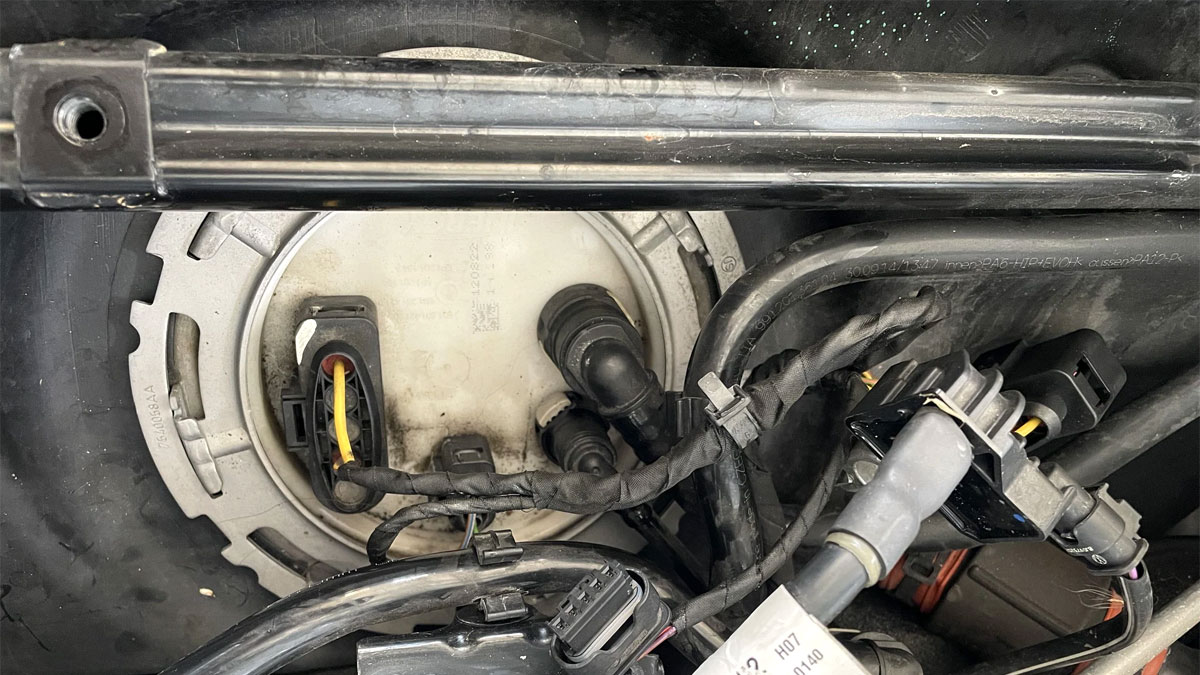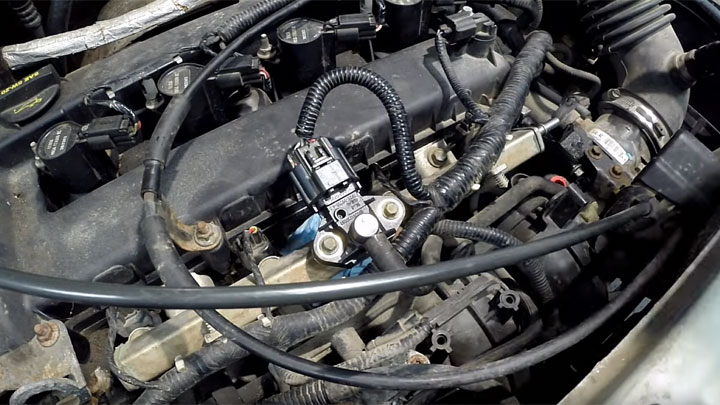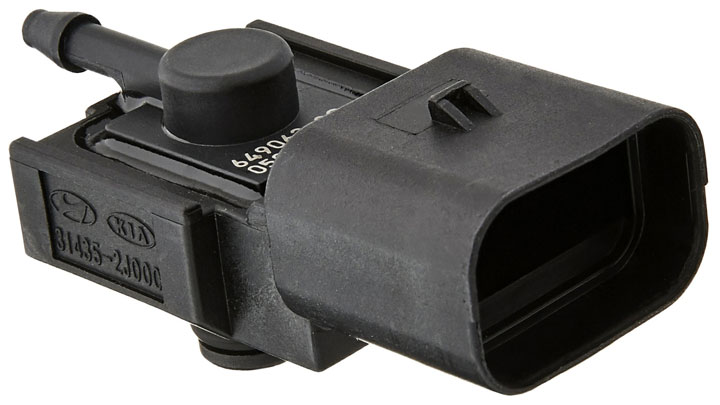5 Symptoms of a Bad Fuel Tank Pressure Sensor (and Replacement Cost)
Evaporative emissions systems rely on the fuel tank pressure sensor. Though this sensor has been re-engineered on multiple levels to last a long time, failure can eventually occur.
Learn the warning signs of a bad fuel tank pressure sensor, what causes it to fail, where it’s located, and how much it’s going to cost you to replace it.

See Also: 3 Signs of a Bad Fuel Sending Unit
Bad Fuel Tank Pressure Sensor Symptoms
A failed fuel tank pressure sensor typically presents very few secondary symptoms. This stems from the fact that feedback from this sensor is used for little more than formulating an effective evaporative emissions protocol.
In most cases, there is little chance of encountering true drivability-related issues, as the result of a failed fuel tank pressure sensor. However, this is not to say that they do not occur on a limited basis.
The following are the most common symptoms associated with a faulty fuel tank pressure sensor.
#1 – Illumination of Check Engine Light

When a fuel tank pressure sensor malfunctions one or more diagnostic fault codes are typically stored. When such codes are detected, a vehicle’s check engine light will be illuminated.
DTCs P0442, P0453, and P0455 are three trouble codes that could signify a faulty fuel tank pressure sensor.
#2 – Loss of Fuel Economy
One of the most common symptoms associated with a faulty fuel tank pressure sensor is poor gas mileage all of a sudden. In fact, it is not uncommon to experience a 2-3 mile loss per gallon in fuel economy under these circumstances.
#3 – Noticeable Fuel Odor

One might also notice a rich fuel odor being emitted from their vehicle, in the event that their fuel tank pressure sensor was to fail. This is quite common and is a hallmark of evaporative emissions system-related issues.
#4 – Stalling or Hesitancy Under Acceleration
Though somewhat rare, it is possible for a vehicle to begin stalling intermittently or experiencing hesitation when you step on the gas if fuel tank pressure sensor failure occurs. Likewise, you might also notice that your vehicle becomes noticeably more difficult to start.
#5 – Lack of Power

Another rare, yet possible symptom of fuel tank pressure sensor failure is a generalized lack of engine power. This tends to be especially pronounced during periods of heavy acceleration.
Under such circumstances, a vehicle will feel inherently sluggish, to the point of acting subdued.
Read Also: 5 Symptoms of Low Fuel Pressure
What Is a Fuel Tank Pressure Sensor?
During the early 1970s, the EPA and other environmental agencies began efforts to curtail noxious emissions presented by internal combustion engine operations. Such efforts involved the introduction of evaporative emissions systems, designed to burn gasoline-related vapor that is naturally purged from a vehicle’s fuel tank, by routing such vapors through an engine’s induction tract.
This process involved engineering specialized equipment aimed at monitoring, capturing, and redirecting these vapors as necessary. One such component produced during this era was the fuel tank pressure sensor. These sensors have since been re-engineered on multiple levels, and are still currently in use today in almost every street-legal automobile.
The fuel tank pressure sensor serves as a vital part of a vehicle’s evaporative emissions control system. This sensor provides feedback regarding the overall pressure of the fuel vapor contained within a vehicle’s fuel tank.
This information is interpreted by a vehicle’s control software, in a bid to establish an efficient emissions control formula.

Where Is It Located?
A vehicle’s fuel tank pressure sensor is typically incorporated into the fuel pump assembly itself. As such, this sensor is generally found mounted atop a vehicle’s fuel tank, or within the fuel tank itself. This positioning seldom proves ideal when replacement is required, as fuel tank removal is generally necessitated.
Despite this fact, those with access to a suitable automotive lift can still perform such replacement without much in the way of major issues. However, you must also keep safety in mind, as a gas tank can represent a hazard of its own, due to its large size and considerable weight.
For that reason, you must stay out of the direct path of a vehicle’s fuel tank, should it become unstable and fall during the removal process.
Read Also: Where Is the Fuel Pump Relay Located?
Fuel Tank Pressure Sensor vs Fuel Rail Pressure Sensor

A vehicle’s fuel tank pressure sensor and fuel rail sensor are completely different components from one another. A vehicle’s fuel tank pressure sensor is part of the evaporative emissions system and is used to provide feedback regarding the overall pressure of a vehicle’s fuel tank at any one given instance.
On the contrary, an engine’s fuel rail pressure sensor serves as a vital part of a vehicle’s fuel system, providing constant feedback regarding the presence and pressure of fuel occupying an engine’s fuel rail. This feedback is representative of the fuel available to the fuel injectors of each respective cylinder.
What Causes an FTP Sensor to Fail?
There are various possible causes behind the failure of a vehicle’s fuel tank pressure sensor, all of which bear consideration. However, the most common of these causes revolve around standard wear and tear.
Over time, electrical components suffer at the hands of various environmental stressors. Vibration, chemical contamination, and temperature extremes are just a few of these stressors that can shorten the life of a fuel tank pressure sensor.
Additionally, any fuel tank-mounted electrical accessory, such as a fuel tank pressure sensor, is prone to damage resulting from underbody debris strikes.
As roadway debris is kicked up beneath a vehicle, it is not uncommon for a vehicle’s fuel tank to take its fair share of abuse. Subsequent disturbances of this type take an inevitable toll on a vehicle’s fuel tank pressure sensor.
Fuel Tank Pressure Sensor Replacement Cost
Best places to order parts? See: 19 Best Online Auto Parts Stores

The exact cost of having a vehicle’s fuel tank pressure sensor replaced tends to differ greatly from one model of vehicle to the next. This stems from the fact that the parts and labor involved with completing such repairs almost always vary on a case-by-case basis.
Generally speaking, one can expect to pay $250-$400 to have their vehicle’s fuel tank pressure sensor replaced. The parts alone to complete such repairs average $100-$150, while labor costs tend to run another $150-$250.
Despite these averages, the cost to complete such repairs can run significantly higher, under certain circumstances.
How Long Does It Take To Replace the Sensor?
Under the majority of circumstances, replacing a vehicle’s fuel tank pressure sensor is a rather labor intensive repair. This is due to the fact that a vehicle’s fuel tank generally has to be dropped, in order to access the fuel tank pressure sensor itself. This typically requires the use of a specialty automotive lift.
In general, even with all necessary equipment at the ready, one can expect to spend between 2-3 hours, to successfully replace their vehicle’s fuel tank pressure sensor.
In rare cases, an even greater amount of time might need to be allotted, in order to facilitate replacement, especially when a fuel tank’s secure mental straps have become rusted, or otherwise corroded.
- P0480 Code (Symptoms, Causes, and How to Fix) - Apr 19, 2024
- Car Temperature Gauge Stopped Working? (Here’s Why) - Apr 15, 2024
- Ignition Coil vs Coil Pack (What’s the Difference?) - Apr 8, 2024
